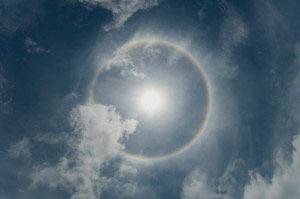Bad Eyesight? Here Are Symptoms You Should Never Ignore.
While many eye related problems start to appear with age, there are many symptoms that point to a more serious problem and should never be ignored. If you experience any of these you should immediately contact your optometrist or ophthalmologist.
1. Tunnel Vision: Tunnel vision is the common term used to describe the loss of peripheral vision- vision that is outside of the centre of ones gaze. This is usually a sign of glaucoma and should be immediately treated. Glaucoma is caused by pressure due to the build of fluid in the eye, causing damage to the optic nerve. Loss of vision typically starts as an arc above or below the centre of your vision while looking straight ahead. If left untreated the blank area expands. Although damage cannot be repaired, eye drops as well as beta-blockers help to prevent further loss of sight.

2. Eyelid Bumps: Swelling, lumps or waxy red lesions are often symptoms of a common skin cancer known as basal cell carcinoma. This typically occurs on the lower and inner corners of your eyelids. Basal cell carcinoma is caused by overexposure to UV radiation caused by the sunlight, therefore it is important to wear sunglasses. There are many treatments available, so contact your eye doctor if you notice any of these symptoms.

3. Seeing Halos: Seeing halos or rainbows around light is a sign that your eye is not filtering light correctly, causing it to scatter on the cornea or lens. This is often caused by cataracts, a clouding on the lens. Cataracts eventually require surgery and if left untreated, can lead to blindness. Contact your optician immediately.

4. Wavy Lines: If you are experiencing distorted central vision, such as seeing wavy lines instead of straight lines, you should see your optician. Distorted vision can indicate macular degeneration, a common disease in people over 60. This condition is caused by damaged blood vessels. Macular Degeneration can cause vision loss very quickly, see an expert immediately.

5. Flashes of Light: Flashes of light in the corner of the eye indicate the possibility of vitreous detachment. Vitreous refers to the gel-like fluid the fills the eye, connecting to the retina and optic nerve. As people age the vitreous becomes more watery and flexible as it begins to pull away from the retina, causing a disruption to vision. While this is normal, it’s important to call your doctor if you experience a continued pulling sensation. This could be caused by the retina becoming detached, which may lead to vision loss if left untreated.

6. Light Sensitivity: While squinting in the sun is normal, persistent pain in the eye while looking at light should assessed by your optometrist. This could be a sign of an infection such as conjunctivitis which usually clears up on its own. Light sensitivity could also be a sign of oculomotor damage, which also heals on its own in about 6 weeks.

7. Struggling to See at Night: The inability to see well in dim lighting is often a sign of retinitis pigmentosa. Retinitis pigmentosa is an inherited disorder which causes the photoreceptors, cells that detect light, to die off. Sight loss progresses slowly over many years. There is currently no treatment.





